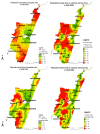Geographic access to care is not a determinant of child mortality in a rural Kenyan setting with high health facility density
- PMID: 20236537
- PMCID: PMC2848200
- DOI: 10.1186/1471-2458-10-142
Geographic access to care is not a determinant of child mortality in a rural Kenyan setting with high health facility density
Abstract
Background: Policy-makers evaluating country progress towards the Millennium Development Goals also examine trends in health inequities. Distance to health facilities is a known determinant of health care utilization and may drive inequalities in health outcomes; we aimed to investigate its effects on childhood mortality.
Methods: The Epidemiological and Demographic Surveillance System in Kilifi District, Kenya, collects data on vital events and migrations in a population of 220,000 people. We used Geographic Information Systems to estimate pedestrian and vehicular travel times to hospitals and vaccine clinics and developed proportional-hazards models to evaluate the effects of travel time on mortality hazard in children less than 5 years of age, accounting for sex, ethnic group, maternal education, migrant status, rainfall and calendar time.
Results: In 2004-6, under-5 and under-1 mortality ratios were 65 and 46 per 1,000 live-births, respectively. Median pedestrian and vehicular travel times to hospital were 193 min (inter-quartile range: 125-267) and 49 min (32-72); analogous values for vaccine clinics were 47 (25-73) and 26 min (13-40). Infant and under-5 mortality varied two-fold across geographic locations, ranging from 34.5 to 61.9 per 1000 child-years and 8.8 to 18.1 per 1000, respectively. However, distance to health facilities was not associated with mortality. Hazard Ratios (HR) were 0.99 (95% CI 0.95-1.04) per hour and 1.01 (95% CI 0.95-1.08) per half-hour of pedestrian and vehicular travel to hospital, respectively, and 1.00 (95% CI 0.99-1.04) and 0.97 (95% CI 0.92-1.05) per quarter-hour of pedestrian and vehicular travel to vaccine clinics in children <5 years of age.
Conclusions: Significant spatial variations in mortality were observed across the area, but were not correlated with distance to health facilities. We conclude that given the present density of health facilities in Kenya, geographic access to curative services does not influence population-level mortality.
Figures
Similar articles
-
Sensitivity of hospital-based surveillance for severe disease: a geographic information system analysis of access to care in Kilifi district, Kenya.Bull World Health Organ. 2011 Feb 1;89(2):102-11. doi: 10.2471/BLT.10.080796. Epub 2010 Oct 5. Bull World Health Organ. 2011. PMID: 21346921 Free PMC article.
-
The effect of distance to health-care facilities on childhood mortality in rural Burkina Faso.Am J Epidemiol. 2011 Mar 1;173(5):492-8. doi: 10.1093/aje/kwq386. Epub 2011 Jan 24. Am J Epidemiol. 2011. PMID: 21262911
-
The effect of distance to formal health facility on childhood mortality in rural Tanzania, 2005-2007.Glob Health Action. 2012 Nov 9;5:1-9. doi: 10.3402/gha.v5i0.19099. Glob Health Action. 2012. PMID: 23151364 Free PMC article.
-
Facility distance and child mortality: a multi-country study of health facility access, service utilization, and child health outcomes.Int J Epidemiol. 2017 Jun 1;46(3):817-826. doi: 10.1093/ije/dyw062. Int J Epidemiol. 2017. PMID: 27185809
-
Inequality of child mortality among ethnic groups in sub-Saharan Africa.Bull World Health Organ. 2000;78(1):30-41. Bull World Health Organ. 2000. PMID: 10686731 Free PMC article. Review.
Cited by
-
Effect of geographical access to health facilities on child mortality in rural Ethiopia: a community based cross sectional study.PLoS One. 2012;7(3):e33564. doi: 10.1371/journal.pone.0033564. Epub 2012 Mar 12. PLoS One. 2012. PMID: 22428070 Free PMC article.
-
Estimating hospital catchments from in-patient admission records: a spatial statistical approach applied to malaria.Sci Rep. 2020 Jan 28;10(1):1324. doi: 10.1038/s41598-020-58284-0. Sci Rep. 2020. PMID: 31992809 Free PMC article.
-
Geographical accessibility and spatial coverage modeling of the primary health care network in the Western Province of Rwanda.Int J Health Geogr. 2012 Sep 17;11:40. doi: 10.1186/1476-072X-11-40. Int J Health Geogr. 2012. PMID: 22984920 Free PMC article.
-
Profile: The Kilifi Health and Demographic Surveillance System (KHDSS).Int J Epidemiol. 2012 Jun;41(3):650-7. doi: 10.1093/ije/dys062. Epub 2012 Apr 28. Int J Epidemiol. 2012. PMID: 22544844 Free PMC article.
-
Rural-Urban Differences in Trends in the Wealth Index in Kenya: 1993-2009.Ann Glob Health. 2017 Mar-Apr;83(2):248-258. doi: 10.1016/j.aogh.2017.04.001. Epub 2017 May 20. Ann Glob Health. 2017. PMID: 28619399 Free PMC article.
References
-
- Declaration of Alma-Ata. Lancet. 1978;312:1144. - PubMed
-
- Health, Nutrition and Population Sector Strategy. World Bank; 1997.




